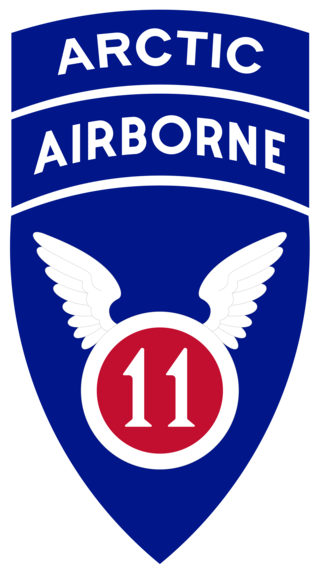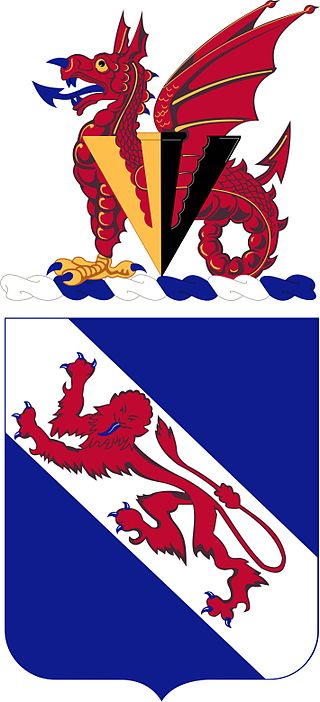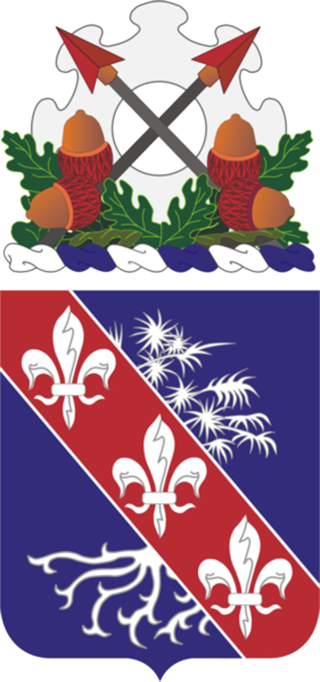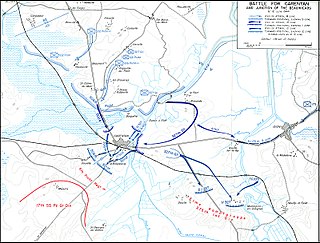
The 82nd Airborne Division is an airborne infantry division of the United States Army specializing in parachute assault operations into hostile areas with a U.S. Department of Defense mandate to be "on-call to fight any time, anywhere" at "the knife's edge of technology and readiness." Primarily based at Fort Liberty, North Carolina, the 82nd Airborne Division is part of the XVIII Airborne Corps. The 82nd Airborne Division is the U.S. Army's most strategically mobile division.

The 10th Armored Division was an armored division of the United States Army in World War II. In the European Theater of Operations the 10th Armored Division was part of both the Twelfth United States Army Group and Sixth United States Army Group. Originally assigned to the Third United States Army under General George S. Patton, it saw action with the Seventh United States Army under General Alexander Patch near the conclusion of the war.

The 11th Airborne Division is a United States Army airborne formation based in Alaska.

The 13th Airborne Division was an airborne forces formation of division-size of the United States Army that was active during World War II. The division was commanded for most of its existence by Major General Elbridge G. Chapman. It was officially activated in the United States in August 1943 at Fort Bragg in North Carolina, remaining active until February 1946, however it never saw combat.

The 17th Airborne Division, "The Golden Talons", was an airborne infantry division of the United States Army during World War II, commanded by Major General William M. Miley.

Operation Varsity was a successful airborne forces operation launched by Allied troops toward the end of World War II. Involving more than 16,000 paratroopers and several thousand aircraft, it is the largest airborne operation ever conducted on a single day and in one location.

The siege of Bastogne was an engagement in December 1944 between American and German forces at the Belgian town of Bastogne, as part of the larger Battle of the Bulge. The goal of the German offensive was the harbor at Antwerp. In order to reach it before the Allies could regroup and bring their superior air power to bear, German mechanized forces had to seize the roadways through eastern Belgium. Because all seven main roads in the densely wooded Ardennes highlands converged on Bastogne, just a few miles away from the border with neighboring Luxembourg, control of its crossroads was vital to the German attack.

The 17th SS Panzergrenadier Division "Götz von Berlichingen" was a German Waffen-SS division that saw action on the Western Front during World War II.

The 508th Infantry Regiment is an airborne infantry regiment of the United States Army, first formed in October 1942 during World War II. The 508th is a parent regiment under the U.S. Army Regimental System, and two battalions from the regiment are currently active: the 1st Battalion, 508th Parachute Infantry Regiment is assigned to the 3rd Brigade Combat Team, 82nd Airborne Division, and the 2nd Battalion, 508th Parachute Infantry Regiment is assigned to the 2nd Brigade Combat Team, 82nd Airborne Division. The regiment served in combat during World War II, and regimental elements have served in combat in the Dominican Republic, Vietnam, Grenada, Panama, Iraq and Afghanistan.

The 507th Parachute Infantry Regiment, now the 507th Infantry Regiment, is an airborne infantry regiment of the United States Army. The regiment was initially assigned to the 82nd Airborne Division in World War II before transferring to the 17th Airborne Division. Now 1st Battalion, 507th Infantry Regiment is part of the United States Army Infantry School, subordinate to its Airborne and Ranger Training Brigade, responsible for the Army's Basic Airborne School, Jumpmaster School, Pathfinder School, and the "Silver Wings" Command Exhibition Parachute Team.

The 517th Parachute Regimental Combat Team was an airborne, specifically a parachute infantry, regiment of the United States Army that was formed in March 1943 during World War II, training at Camp Toccoa in the mountains of Northeast Georgia.

The 504th Infantry Regiment, originally the 504th Parachute Infantry Regiment, is an airborne forces regiment of the United States Army, part of the 82nd Airborne Division, with a long and distinguished history. The regiment was first formed in mid-1942 during World War II as part of the 82nd Airborne Division and saw service in Sicily, Italy, Anzio, the Netherlands, Belgium and Germany.
The 513th Parachute Infantry Regiment was an airborne infantry regiment of the United States Army, raised during World War II. The 513th formed part of the 17th Airborne Division and participated in the European Campaign, fighting in the latter stages of the Battle of the Bulge in January 1945 and parachuted into Germany in Operation Varsity in March, in the largest airborne drop of the war. The regiment returned to the United States in September 1945 where it was inactivated.

The 327th Infantry Regiment is an infantry regiment of the 101st Airborne Division of the United States Army. During World War II, the 327th was a glider-borne regiment of the 101st Airborne Division. It fought during World War I as part of the 82nd Division. It has also been deployed in the Vietnam War, Gulf War, and most recently to Iraq and Afghanistan. The song "Glider Rider" describes (humorously) some of the slights that glider-borne troops felt they received from the Army during World War II; though the regiment's public fame rose with the 1949 movie Battleground about the Siege of Bastogne in late 1944.

The Battle of Carentan was an engagement in World War II between airborne forces of the United States Army and the German Wehrmacht during the Battle of Normandy. The battle took place between 6 and 13 June 1944, on the approaches to and within the town of Carentan, France.
Mission Boston was a parachute combat assault at night by Major General Matthew Ridgway's U.S. 82nd Airborne Division on June 6, 1944, part of the American airborne landings in Normandy during World War II. Boston was a component element of Operation Neptune, the assault portion of the Allied invasion of Normandy, codenamed Operation Overlord. 6,420 paratroopers jumped from nearly 370 C-47 Skytrain troop carrier aircraft into an intended objective area of roughly 10 square miles (26 km2) located on either side of the Merderet river on the Cotentin Peninsula of France, five hours ahead of the D-Day landings.
The 550th Airborne Infantry Battalion was an independent airborne forces formation of battalion-size of the United States Army formed during World War II on 1 July 1941 at Fort Kobbe Panama Canal Zone. The 550th was originally formed as an air landing unit rather than a parachute or glider battalion.

The 88th Infantry Regiment was an infantry regiment of the United States Army. It was created as the 88th Airborne Infantry Battalion on 10 October 1941 during World War II as the U.S. Army's first glider infantry unit.

The 326th Infantry Regiment was an infantry regiment of the United States Army that saw active service during World War I, as part of the 82nd Division and fought in the Meuse-Argonne Offensive and was inactivated in 1919. The regiment was reactivated during World War II, again as part of the 82nd Infantry Division, and was converted into a glider infantry formation, becoming the 326th Glider Infantry Regiment. Originally part of the 82nd Airborne Division, the regiment transferred to the 13th Airborne Division. However, despite training for almost three years, the 326th was never involved in any combat.

The 194th Glider Infantry Regiment was a Glider infantry regiment of the United States Army that served in World War II. It was a part of the 17th Airborne Division, and saw active combat service until its deactivation in 1945.
















